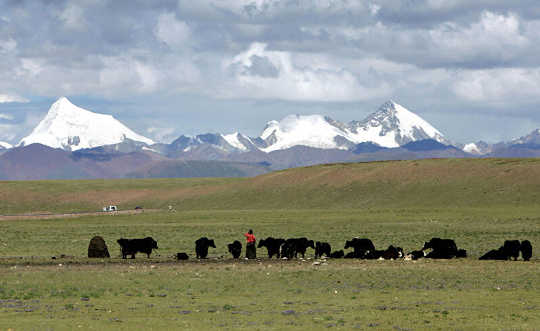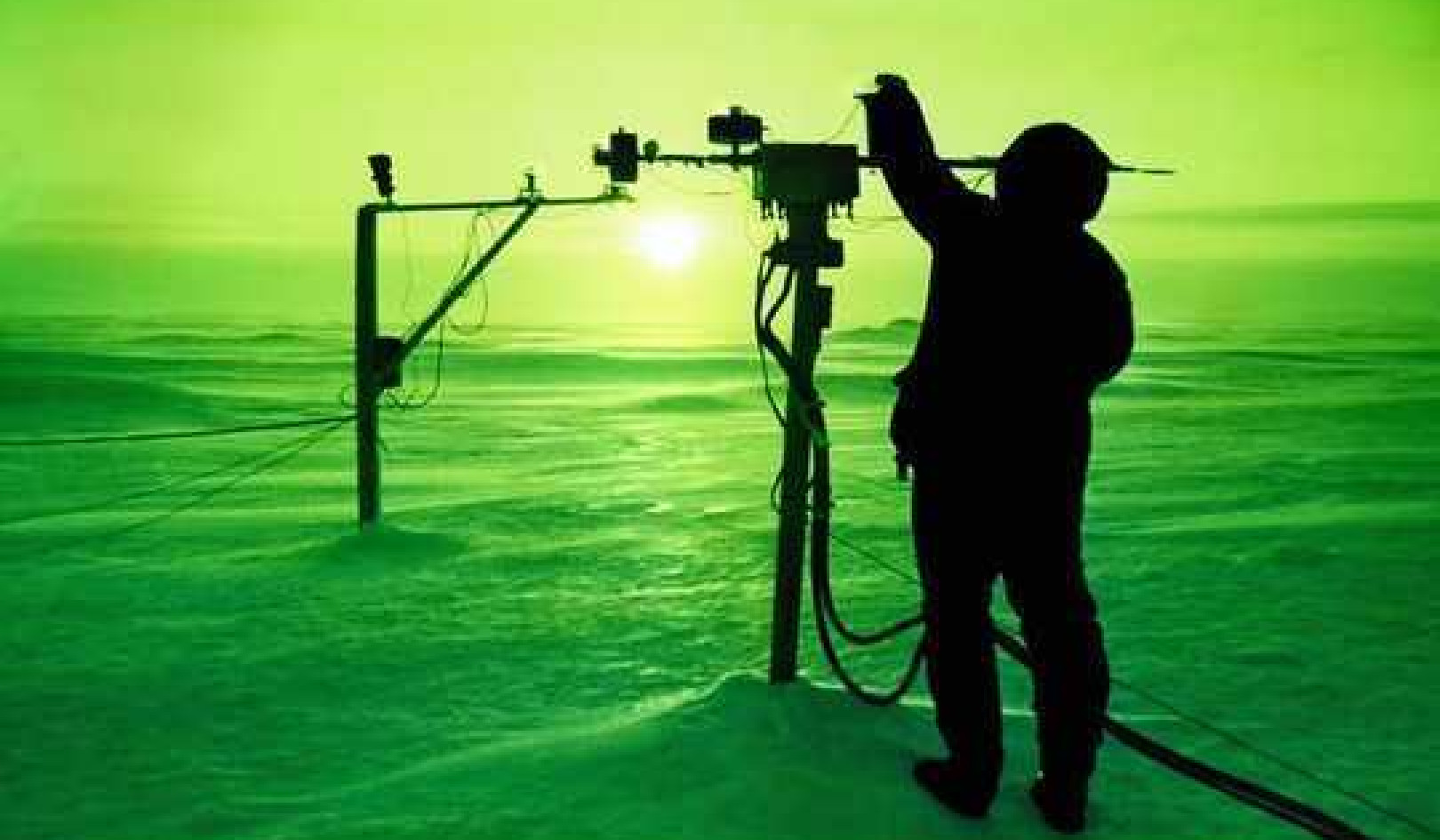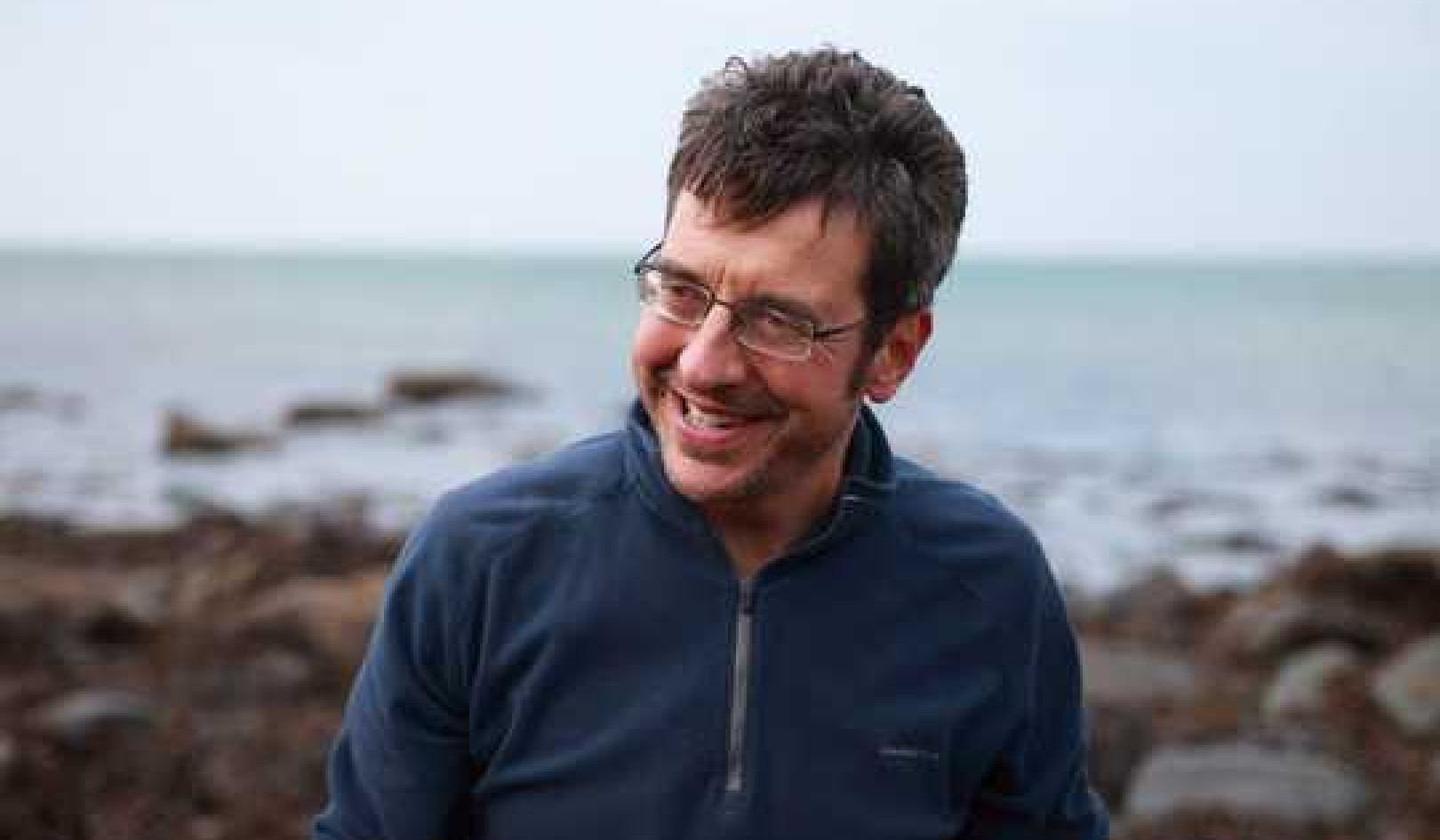
Using lake sediment in the Tibetan Plateau, researchers show that permafrost at high elevations is more vulnerable than arctic permafrost under projected future climate conditions.
From the ancient sludge of lakebeds in Asia’s Tibetan Plateau, scientists can decipher a vision of Earth’s future. That future, it turns out, will look very similar to the mid-Pliocene warm period—an epoch 3.3 million to 3 million years ago when the average air temperature at mid-latitudes rarely dropped below freezing. It was a time when permanent ice was just beginning to cling to the northern polar regions, and mid-latitude alpine permafrost—or perpetually frozen soil—was much more limited than today.
Global permafrost today contains a whopping 1,500 trillion grams of carbon. That’s twice as much as what’s stored in the atmosphere. Alpine permafrost, which is found closer to the equator at high elevations, isn’t as well studied as arctic permafrost but contains 85 trillion grams of carbon. When melted, it can release carbon dioxide and methane—greenhouse gases that influence global temperature.
Alpine permafrost is expected to melt at a faster rate than arctic permafrost under current global warming conditions, according to new research published in Nature Communications, and this may contribute even more to rising global temperatures.
“Atmospheric carbon dioxide concentrations today are similar, or maybe even higher, than the mid-Pliocene because of the burning of fossil fuels, and so scientists point at that time period as an analog for our current and near-future climate,” says paper coauthor Carmala Garzione, dean of the University of Arizona College of Science. “We’re not feeling the full effects of the rise in atmospheric carbon dioxide yet because our Earth system takes time to adjust.”
“We wanted to estimate the stability of modern permafrost globally in a warmer-than-today climate scenario,” says Feng Cheng, the paper’s lead author and a professor at Peking University in China. Cheng formerly worked with Garzione as a postdoctoral fellow. “Our findings were very surprising and highlight the fact that we need to put more effort into monitoring the stability of the permafrost in the alpine region.”
The team used carbonate, a family of minerals, that formed in a Tibetan Plateau lake to estimate temperatures during the Pliocene period (5.3 to 2.6 million years ago) and the Pleistocene period (between 2.6 million and 11,700 years ago). When algae grow in lakes, they absorb carbon dioxide from the water and, as a result, decrease lake acidity. That decrease drives the lake to form finely grained carbonate minerals that settle at the lake bottom. The atoms in that carbonate reflect the temperature at which the carbonate formed and can be used like a time-traveling thermometer.
The Tibetan Plateau, which sits at an elevation over 15,400 feet, is the largest alpine permafrost region on Earth, but others exist in the Mongolian Plateau in central Asia, the Canadian and American Rocky Mountains, the southern stretches of the Andes, and other mountain ranges worldwide at elevations where the air temperature is consistently below freezing.
The team also modeled the paleoclimate on Earth during the Pliocene. They found that the average temperature of much of the Tibetan Plateau above freezing in the Pliocene, and that the same was true for many of the alpine regions across the globe.
Ultimately, the modeling suggests that under current levels of atmospheric carbon dioxide, 20% of arctic permafrost land area and 60% of alpine permafrost land area will be lost in the future. High altitude alpine regions are more sensitive than high latitude arctic regions to warming under higher atmospheric carbon dioxide conditions.
“The Pliocene is an important period as an ancient analog for how Earth will adjust to the carbon dioxide that humans have already released to the atmosphere,” Garzione says. “We need better and broader studies of the vulnerability of alpine regions under global warming scenarios. There’s been a lot of focus on the stability of arctic permafrost, because it covers more land area and contains a huge reservoir of organic carbon trapped in permafrost, but we also need to be aware that alpine regions stand to lose more permafrost proportionally and are important in understanding of potential carbon release under global warming scenarios.”
Source: University of Arizona
Related Books
Life After Carbon: The Next Global Transformation of Cities
by Peter Plastrik , John Cleveland The future of our cities is not what it used to be. The modern-city model that took hold globally in the twentieth century has outlived its usefulness. It cannot solve the problems it helped to create—especially global warming. Fortunately, a new model for urban development is emerging in cities to aggressively tackle the realities of climate change. It transforms the way cities design and use physical space, generate economic wealth, consume and dispose of resources, exploit and sustain the natural ecosystems, and prepare for the future. Available On Amazon
The future of our cities is not what it used to be. The modern-city model that took hold globally in the twentieth century has outlived its usefulness. It cannot solve the problems it helped to create—especially global warming. Fortunately, a new model for urban development is emerging in cities to aggressively tackle the realities of climate change. It transforms the way cities design and use physical space, generate economic wealth, consume and dispose of resources, exploit and sustain the natural ecosystems, and prepare for the future. Available On Amazon
The Sixth Extinction: An Unnatural History
by Elizabeth Kolbert Over the last half-billion years, there have been Five mass extinctions, when the diversity of life on earth suddenly and dramatically contracted. Scientists around the world are currently monitoring the sixth extinction, predicted to be the most devastating extinction event since the asteroid impact that wiped out the dinosaurs. This time around, the cataclysm is us. In prose that is at once frank, entertaining, and deeply informed, New Yorker writer Elizabeth Kolbert tells us why and how human beings have altered life on the planet in a way no species has before. Interweaving research in half a dozen disciplines, descriptions of the fascinating species that have already been lost, and the history of extinction as a concept, Kolbert provides a moving and comprehensive account of the disappearances occurring before our very eyes. She shows that the sixth extinction is likely to be mankind's most lasting legacy, compelling us to rethink the fundamental question of what it means to be human. Available On Amazon
Over the last half-billion years, there have been Five mass extinctions, when the diversity of life on earth suddenly and dramatically contracted. Scientists around the world are currently monitoring the sixth extinction, predicted to be the most devastating extinction event since the asteroid impact that wiped out the dinosaurs. This time around, the cataclysm is us. In prose that is at once frank, entertaining, and deeply informed, New Yorker writer Elizabeth Kolbert tells us why and how human beings have altered life on the planet in a way no species has before. Interweaving research in half a dozen disciplines, descriptions of the fascinating species that have already been lost, and the history of extinction as a concept, Kolbert provides a moving and comprehensive account of the disappearances occurring before our very eyes. She shows that the sixth extinction is likely to be mankind's most lasting legacy, compelling us to rethink the fundamental question of what it means to be human. Available On Amazon
Climate Wars: The Fight for Survival as the World Overheats
by Gwynne Dyer Waves of climate refugees. Dozens of failed states. All-out war. From one of the world’s great geopolitical analysts comes a terrifying glimpse of the strategic realities of the near future, when climate change drives the world’s powers towards the cut-throat politics of survival. Prescient and unflinching, Climate Wars will be one of the most important books of the coming years. Read it and find out what we’re heading for. Available On Amazon
Waves of climate refugees. Dozens of failed states. All-out war. From one of the world’s great geopolitical analysts comes a terrifying glimpse of the strategic realities of the near future, when climate change drives the world’s powers towards the cut-throat politics of survival. Prescient and unflinching, Climate Wars will be one of the most important books of the coming years. Read it and find out what we’re heading for. Available On Amazon
From The Publisher:
Purchases on Amazon go to defray the cost of bringing you InnerSelf.comelf.com, MightyNatural.com, and ClimateImpactNews.com at no cost and without advertisers that track your browsing habits. Even if you click on a link but don't buy these selected products, anything else you buy in that same visit on Amazon pays us a small commission. There is no additional cost to you, so please contribute to the effort. You can also use this link to use to Amazon at any time so you can help support our efforts.





























